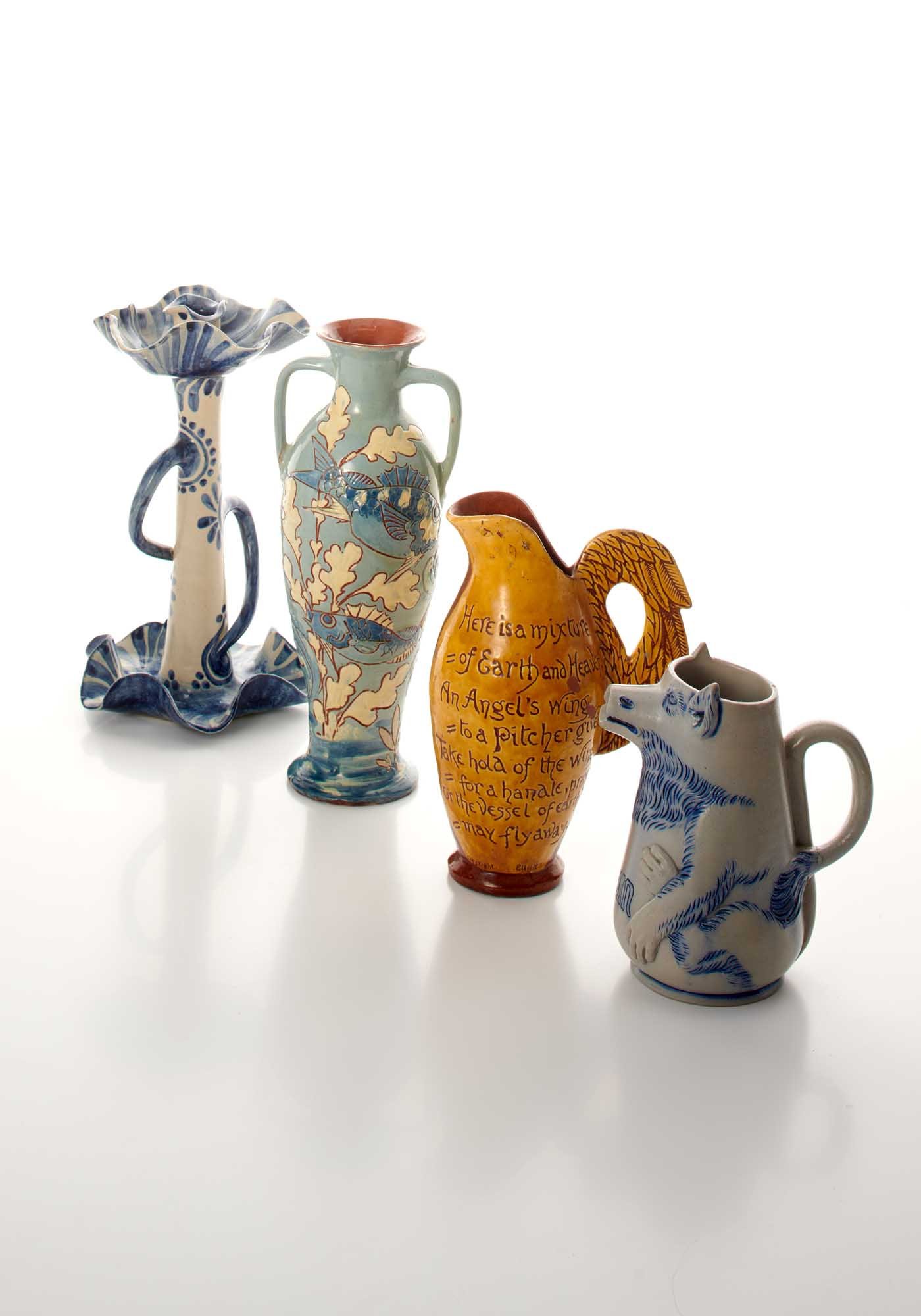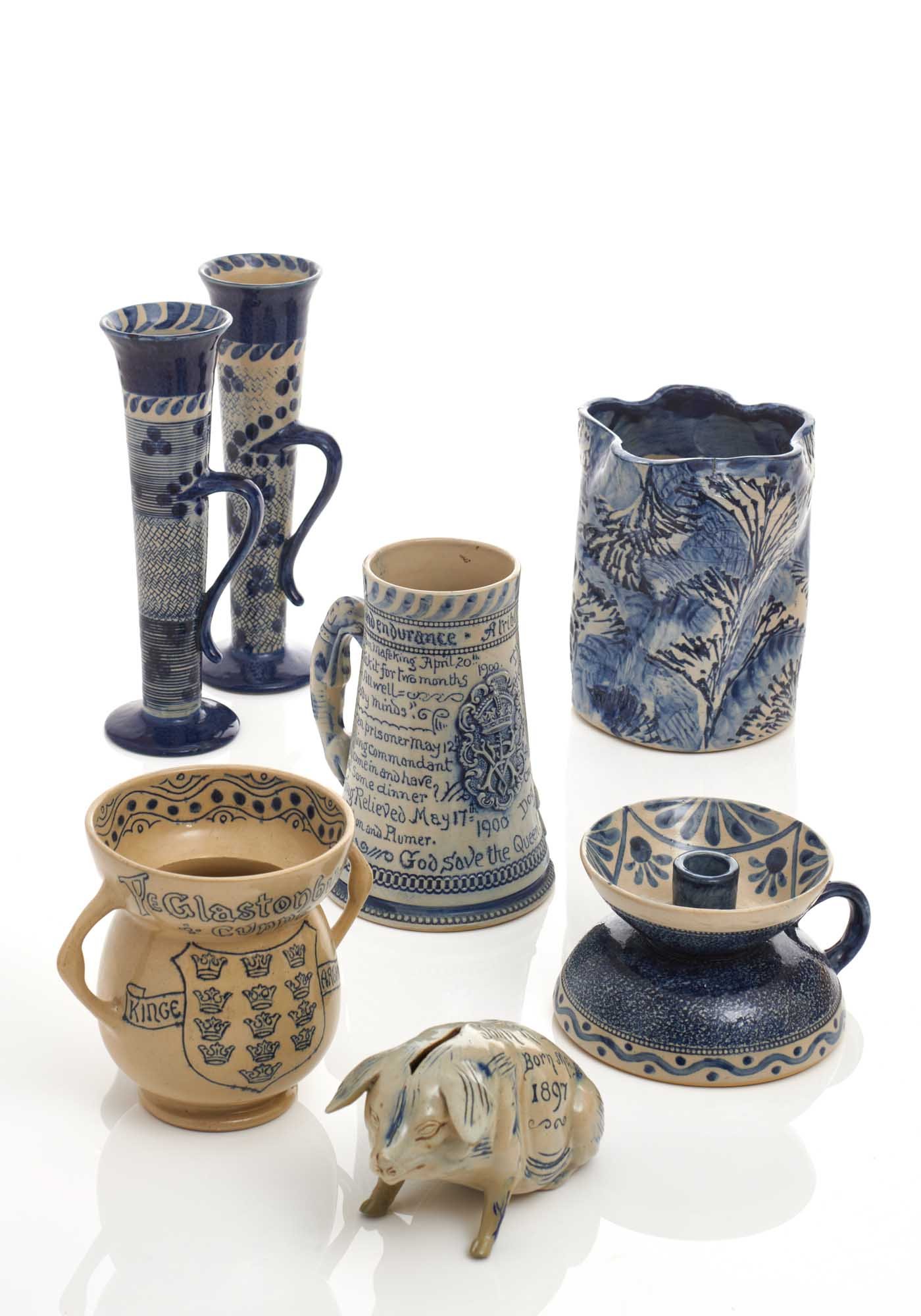
About Horace Elliott
Horace Elliott 1851-1938) was born on 24th January 1851. His father was the architect George Augustus Elliott (1823-1896).
It was in 1880 that Horace started selling the wares of William Doel of Ewenny, South Wales, at an undisclosed shop on Great Russell Street. He had met Doel when on unrelated business in SouthWales. This was around the time when Art Pottery production moved outside London – it was 1879 when the architect Owen Davis (1838-1913) sent a design to C.H. Brannam (1855-1937) in Barnstaple to copy. That same year, Sir E. H. Elton (1846-1920) went to the local brickworks to investigate the manufacture of tiles and started on a long series of tile firings in the second half of 1880. So Horace was getting involved in something new. Horace switched from Commercial Traveller to Art Pottery in 1885 (if not slightly before).
Elliott’s story, as a ceramic designer, maker, retailer is complex. Elliott in the 1911 Census described himself as an “Artist Potter – Useful and ornamental pottery – I design, partially make, and decorate same, Stoneware & Redware.” He made these products with over a dozen British and Continental pottery workshops or factories through his 54-year career (at least three at Ewenny and in nearby villages, potentially one or two potteries in Cardiff, Denby, C.H. Brannam, Stiff & Co., a yet unidentified English porcelain maker, probably Cumnock and Wemyss in Scotland, Wilhelm Strödter and others in Westerwald Germany and possibly many more). Horace was employing these factories to make his wares and, at times, was actively involved in production and/or decoration.
Below: The only known photograph of Horace Elliott (second right), standing outside the Ewenny Pottery in 1896. © Caitlin Jenkins, Ewenny Pottery

Horace organised his business from various shops in London, initially running an “art pottery depôt” on what is now Queensway, Bayswater (from 1885) and a shop in Knightsbridge (probably slightly later) before apparently closing both and moving in turn to Chelsea (in 1898) and then Streatham (c1905), where he retired in 1934, aged 83. Elliott registered his trademark for the Fleur-de-Lys Pottery in 1883 and, from 1886, had an arrangement with Denby to make moulds of his ceramic designs which Elliott “could use anywhere”. Denby could use them too.
Elliott’s story, as a ceramic designer, maker, retailer is complex. Elliott in the 1911 Census described himself as an “Artist Potter – Useful and ornamental pottery – I design, partially make, and decorate same, Stoneware & Redware.”



At his peak, Horace Elliott was in the British art pottery premier league, exhibiting with recognised leaders of his field, including William De Morgan, Ault and Dresser, the wares of Sir E.H. Elton and industry giants such as Doulton, Royal Worcester, Minton, Coalport etc. He exhibited at three of the William Morris/Walter Crane Arts & Crafts Exhibition Society exhibitions in Regent Street in 1889, 1890 and 1893. Elliott was awarded a prize by the Society of Arts at the first of these in 1889 – he was among prestigious company – the other prize winners were Edith Lupton, Mark Marshall, Walter and Jesse Gandy from Doulton; Dewdney, Brown and Bamkin from Brannam; and Fred Passenger and H. Bales (tiles) at William De Morgan.
At his peak, Horace Elliott was in the British art pottery premier league, exhibiting with recognised leaders of his field, including William De Morgan, Ault and Dresser, the wares of Sir E.H. Elton and industry giants such as Doulton, Royal Worcester, Minton, Coalport etc.
Elliott also sold at exhibitions and bazaars. He showed wares at the prestigious Imperial Institute exhibition in 1894 and, in the same year, at Araby in Dublin – and is probably referred to in James Joyce’s short story of the same name published in Dubliners (1914). Horace also took part in the Charing Cross Hospital bazaar at the (Royal) Albert Hall in 1899 and his wares featured at the St. Louis World Fair in 1904.
Little is known about his customers, but the three which are recorded (Mrs Beale from Standen, Alfred Dunhill and Baden-Powell) all occupied senior positions in English society. Horace also presented his ‘Royal Presentation vase’ made with the Jenkins at Ewenny Pottery to mark the 1893 marriage of Prince George and Princess May, which was generously deposited by their Majesties (then King George V and Queen Mary) at the National Museum of Wales in Cardiff in 1930.
Over 90% of the information included in the book is based on primary source material not previously published. Key documents include the full run of correspondence between Horace Elliott and Dr (later Sir) Cyril Fox and Lord Stamfordham, the latter writing from Windsor Castle and Buckingham Palace. These ere are unpublished letters and designs from the Denby archives held at the Derbyshire Record Office, newly discovered letters between Horace and Mr. Heuss in Westerwald relating to German orders, and various exhibition catalogues, newspaper articles, registered designs and surviving moulds.
Together, these prove that Horace Elliott was a leading member of the Arts and Crafts movement, certainly in the 1890’s when he appeared to be at his creative peak.
